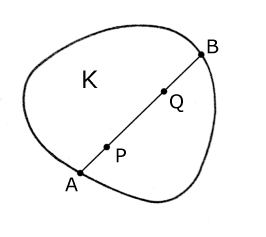Update to Appendix 5: Determination of the Mean Length of a Ley
Michael Behrend, 2014
This update discusses theoretically the “mean length of a ley” that is used in the Furness formula. Let K be any bounded convex plane region, let points P and Q have independent uniform distributions in K, and let A and B be the ends of the chord through P and Q (see diagram).

The object is to find the mean length of AB as P and Q vary. In such problems it is often easier to work in terms of the length PQ, using the fact that for integer m≥0,
|
(A proof of this theorem is given elsewhere on this website.) In our case m=1, giving
|
For K a rectangle (e.g. a map sheet) of size a×b, define d=√(a2+b2). After some tedious integration we find
|
An alternative method, which also serves as a check on the theory, is to use a computer to select random points P and Q, calculate the length of AB, and take the mean over many random choices.
The values of the mean ley length obtained by these methods are shown in the following table.
| Rectangle size |
Theory | Mean of 108 simulations |
|---|---|---|
| 1 × 1 | 1.042811 | 1.0428 |
| 1 × 1.5 | 1.317067 | 1.3171 |
| 1 × 2 | 1.609544 | 1.6096 |